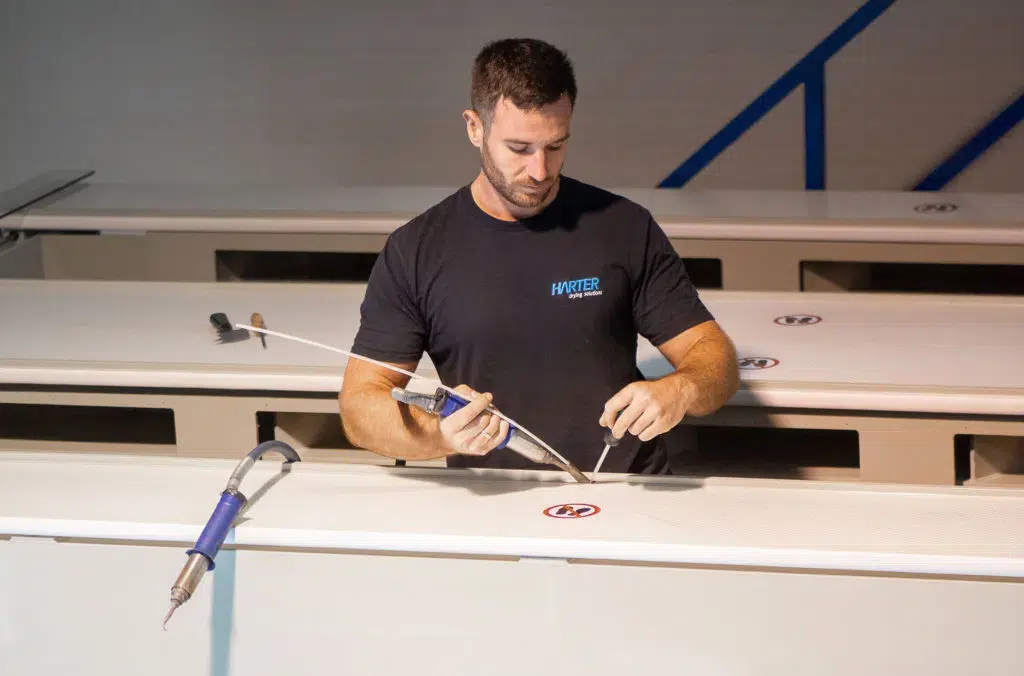No Dust Stirred up During Drying
Three M5 type sludge dryers for drying a total of 3.6 tons of sludge per working dayA sealing hood with nine special filter cartridges completely seals the sludge cart during drying to keep the system’s heat exchangers clean.The thin sludge awaits drying in the sludge cart.The drier the sludge, the lower the energy consumption for processing metals from battery sludges. A simple calculation that makes a newly developed drying system based on the heat pump principle a lucrative investment for a recycling company. With the heat pump principle, the operator dries the thin sludge with low dust emission and efficiently.
Without batteries, there are no mobile phones, no e-cars, and no e-bikes. But what happens to these powerhouses when they have reached the end of their life? Previously, they often ended up in landfills, but since the introduction of a recycling law, recycling rates have increased, and batteries have become a raw material from which some valuable metals are extracted again. Analysts at Markets and Markets estimate that the battery recycling market will grow by 6.1% annually from 2020 to 2025, from a total of 17.2 billion dollars in 2020 to 23.2 billion dollars by 2025. An exciting field, therefore, in which a handful of specialists from all over the world operate.
Specialists in Battery Recycling
These include Umicore in Belgium, Glencore in Canada, and Euro-Dieuze Industrie (EDI). The Veolia subsidiary from France specializes in recycling batteries from household appliances and for electric vehicle drives. Annually, 6,000 batteries, with an increasing proportion of electric car batteries, are collected, shredded, their valuable materials recovered, and returned to the material cycle at the French site. In this process, 1,000 tons of thin sludge are produced annually, which must be dried to extract the coveted metals and rare earths. The Veolia subsidiary is particularly focused on nickel and has developed a hydrometallurgical process for battery reprocessing.
Sludge Drying Reduces Disposal Costs
Sludge drying is typically used because companies want to minimize their disposal and transport costs. By removing water, the weight and volume of the sludge are reduced by up to 60%. This can potentially reduce landfill costs by up to 60%. The drying system manufacturer HARTER from Allgäu launched a particularly energy-saving sludge drying system almost 30 years ago, which still serves a market niche today. An interesting cost calculation for many companies.
At EDI, the initial situation was different due to recycling. In this process, metal hydroxide sludges are produced, which are dewatered in chamber filter presses. What remains is a filter cake that still has a residual moisture content of 70%. To extract nickel from the sludge, a residual moisture content of only 8% is required, which necessitates sludge drying. A challenge for the project team at HARTER: For the first time, the drying specialist faced the requirement for such a low residual moisture content. Operators usually dry their sludges only to a residual moisture content of approximately 75%. In this range, the highest volume and weight reductions are achieved. Further drying is no longer economical.
Additional Dedusting in the Dryer
What does EDI’s requirement mean for the construction of the system? The dryer manufacturer was aware that increasingly strong dust generation begins at a residual moisture content of approximately 25%. The filters normally used in a sludge dryer would no longer be sufficient here. The heat exchangers in the system would become contaminated, which would ultimately lead to a loss of performance. To prevent this, HARTER developed its own dedusting unit for the EDI project.
The sludge drying system consists of a sludge cart and a dehumidification unit. The filter cake is discharged from the filter press into the cart and dried there. In the dehumidification unit, the required process air is conditioned: extremely dry air.
This unsaturated air is guided via insulated air ducts into the sludge cart and absorbs moisture there. The cart is equipped with a special ventilation floor, and the air guidance is designed so that the dry process air flows evenly from below through the filter cake, drying it gradually.
The moisture-laden air returns to the dehumidification unit. There, it is cooled, the water condenses out, and leaves the system as condensate. Subsequently, the air is reheated and recirculated. This “condensation drying with heat pump” is the only system on the market that operates completely exhaust-air-free.
This article was first published on October 19, 2020, on PROCESS published.
